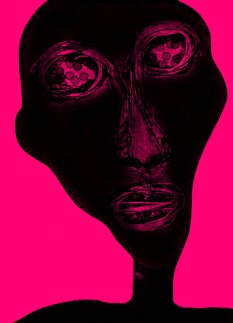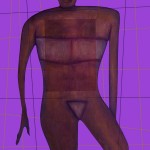Forms of Human Cosmicisation : An Angolan Pwo Mask and Evelyne Huet’s Kimpa Vita-Nsimba by Oluwatoyin Vincent Adepoju, Founder and Director at Compcros : Comparative Cognitive Processes and Systems
2014-04-23
- Oluwatoyin Vincent Adepoju:My God.This is sublime, Evelyne Huet.Would you like to reflect on the relationship between masking and your own art, perhaps in terms of recreations of the human face?
Dear Oluwatoyin Vincent Adepoju, thank you very much for this very kind suggestion!
I will not follow it because this mask, as many others, is a pure marvel that has probably been an object of worship for centuries and because I feel it unthinkable to offend the Gods, the artists who made these beauties and the dead and living persons who honoured these representations…And I think I would be doing that if I were to build a detailed ‘written’ link between my very modest works and these quite cosmic and eternal Masterpieces!
Of course my distortions of faces are much influenced by the masks of the Ancient cultures, but I will not dig more since it would inevitably be an offending (and quite egotic!) introspection.. . But thank you again, anyway, for this very kind suggestion.
Oluwatoyin Vincent Adepoju Thanks, Evelyne Huet.
I hope you wont mind if I do the job, then?
Of course not Oluwatoyin Vincent Adepoju.. It will be a delicious pleasure for me to read how you perceive this.. And since narcissism is totally different from egotism, I won’t feel offended.
Thank you very much for having this kind idea.
(Source : The Cosmos of World Art and Correlative Cultural Forms
https://www.facebook.com/groups/158308031011331/permalink/275574862617980/?stream_ref=3). Accessed 23/04/2014.
I find this summation of this mask in relation to her own work by Evelyne Huet deeply moving.
Where may we find resonances between the engagements with the human face represented by the « cosmic and eternal masterpieces » as Evelyne Huet describes the Pwo mask above and Huet’s own explorations of the human face?
Is Huet’s work any less cosmic and eternal?
Evelyne Huet’s Kimpa Vita-Nsimba
The Pwo mask radiates a serene majesty in its contemplative balance, while Huet’s Kimpa Vita-Nsimba is both contemplative and seemingly radiating deep pools of pathos in eyes that seem aglow with constellations awash in the fluid of life, blood, as the modelling of the face and body may suggest the self reshaped in terms of a plasticity revealed when passed through fire, leaving a malleably shaped form.
Am I influenced in my response to Huet’s Kimpa Vita-Nsimba by her description of her painting as well as by her engagement with the Pwo mask?
Quoting Courrier International n°1219 and to Wikipedia, she describes her painting as evoking :
« Kimpa Vita-Nsimba (ca1685-1706), the Congolese prophet who founded the Antonianism, or Antonine sect. She grew up in a climate of war between different tribes of the Kongo kingdom.
From her childhood, she was recognized as nganga marinda – eg an intermediary between the human world and the spirit world.
She was nicknamed « the Joan of Arc of the Kongo », acquiring over the years a power that threatened the king and missionaries.
Dona Beatriz and her family were burnt at the stake as heretics on July 2nd, 1706, two years after her arrival in Mbanza-Kongo ».
Perhaps these deeply resonant words from Evelyne Huet on the mask and her own work influence my response to both creations.
The eyes of the woman of the mask are closed in meditation, the cosmic and celestial forms on her forehead and cheeks, in harmony with what are described as tears leading from her eyes to the solar images on her cheek, suggest both a grounding in the pains and joys of human existence and the alignment of these visceral aspects of human life with the cosmos.
A great evocation of being and becoming in the broadest sense, unifying identification with the existential depth of human experience and its cosmic context within a contemplative immersion suggested by the structural balance and half closed eyes of the serene face.
An emotional balance emerges in both works, a sense of deep inner equilibrium reached in spite of profound insight into the contradictions between human existence and human possibility, within the tears, perhaps of sorrow, in the Pwo mask, or perhaps of joy, as human experience is plumbed in its cosmic context, and in Evelyne Huet’s Kimpa Vita-Nsimba, whose soulful, mesmeric and mysterious eyes seem to gaze into cosmoses of possibility both within and beyond her, possibilities alive with the keen blood of human being as suggested by the sea of color within her eyes, and the background of her face, not crimson but evocative of crimson, as the deep black of her body deepens the work in terms of an amazing gravitas.
The mask seems to evoke a primevality of power in the elements that make it up and the way they are constituted, its earthen color suggesting the human feet that walk the earth, the human life that feeds on the fruit of the earth, the human tears and blood that mix with that earth, an almost chthonic evocative scope reinforced by the dark brown, heavily textured net that covers the back of the figure, feminising her further in resonance with the delicate power of her facial beauty.
What resonance with this earthen potency may be seen as emerging from the Congolese prophet as visualised by Evelyne Huet?
Where may the two women meet within the evocation of the quiet potency of the numinous radiating from the mask?
Is it in the internally centred power of both forms, concentrated in the deep black welling from within Vita-Nsimba’s form, resonating with the cosmological depth of her eyes?
The black of earth depths, the black of concealing, empowering and rejuvenating night, the black of unknowing, the unknowing of ignorance as well as of transcendence of the known?
The black whose palpitating possibility is manifest in eyes that are constellated by inner fires as these resonate with a cosmic depth from which perhaps vision emerges?


